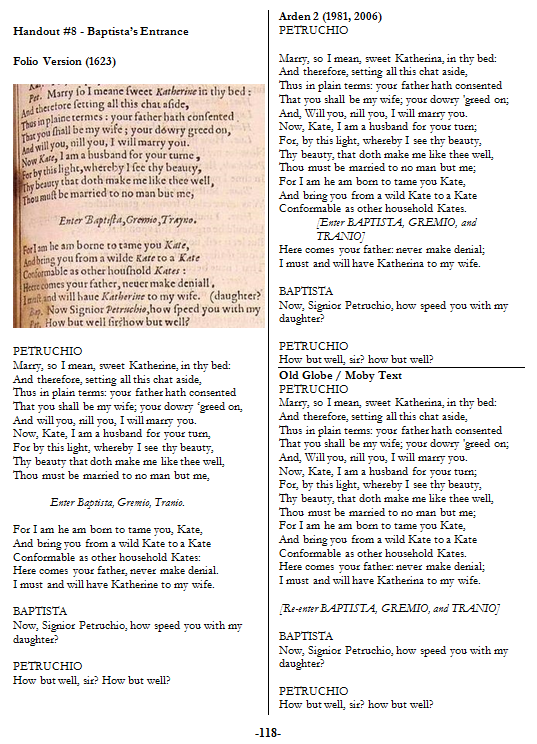The Taming of the Shrew is, admittedly, a controversial play. I don’t mind that. I like controversy. It gets people talking. Personally, I have a sort of winding history with the play. As a young teenager, I loved it because I loved Kate. Like my all-time favorite heroine, Beatrice, Kate is witty and sharp and sarcastic. She has an edge to her, too, though, something either dark or sad that I didn’t fully appreciate until later in life. A little later on, I went through a period of stridently disliking the play, partially for feminist reasons, and partially because I wasn’t seeing very good productions. But I was willing to be convinced, and by the time I hit grad school, I was coming around on it. And then, my first year with the ASC, we explored a scene in a Teacher Seminar that blew the doors open for me.
For me, this entire play now hinges on a single stage direction. It’s a tiny change that can seal the difference between Petruchio-as-bully and Petruchio-as-actor/teacher, and that’s the focus of the Textual Variants activity in our brand-new Study Guide. Here’s a sneak peek — and if you want to see it in action, register now to join us for the Winter Teacher Seminar, January 30-31.
Textual Variants
Stage Directions
Handout #8 shows your students the Folio version of The Taming of the Shrew on one side and two common editorial variations on the other. The first, as shown in the 2nd edition of the Arden Shakespeare version of the play, moves Baptista’s entrance to just before Petruchio says “Here comes your father.” (The 3rd Arden edition reverts to the Folio placement). The second, the Old Globe Text as available online through the Moby Shakespeare posted at shakespeare.mit.edu, moves the direction all the way to the bottom of Petruchio’s speech.
Activity: Baptista’s Entrance
- Discuss the process of early modern text transmission. (You can find the details in The American Shakespeare Center’s Taming of the Shrew Study Guide, available at the Teacher Seminar coming up on January 30-31 or on Lulu).
- Give your students Handout #8.
- Select volunteers or assign five students to play the roles of Petruchio, Kate, Baptista, Gremio, and Tranio. Only Petruchio and Baptista have to talk, though Kate should be prepared to react non-verbally to what they say.
- Work first through the Folio version of the scene. Your Teacher’s Guide gives suggestions on how to make discoveries with the scene in your classroom.
- Discuss:
- In this version, Petruchio is still talking about his attraction to and admiration for Kate right up until Baptista and the others enter, when he switches to the “taming” language – what he promised Baptista he would do, but nothing like what he has said to Kate so far.
- What prompts Petruchio’s shift to the taming language?
- How might his delivery change when he shifts to the taming language?
- When is Petruchio sincere in this monologue and when is he putting on a show? (See Staging Challenges: Actors Playing Actors in the Study Guide for more). How can an actor perform the difference between sincerity and showmanship?
- Your students may not have a clear answer for this yet. Ask them to keep it in mind during the following explorations of the scene:
- Work through the Arden and Old Globe versions of the scene, changing the timing of Baptista’s entrance.
- Note that brackets “[ ]” indicate when an editor has moved or changed a stage direction.
- How can changing the entrance of Baptista and the others change Petruchio’s delivery of the final lines of his monologue?
- Play the Folio version one more time, so that it is fresh in your students’ minds for the rest of the discussion.
- Discuss:
- What repercussions can this change have for the rest of the scene and the rest of the play? If Petruchio is genuinely attracted to Kate and only putting on the show of being “born to tame” her, how can that inform his other interactions with her? On the other hand, if he truly believes that that is his role, how will that change their relationship over the rest of the play?
- If your students have not yet read the rest of the play, ask them to keep these questions in mind as they do so.
- What version do your students prefer? What version would they rather see staged?
- In what version is a happy ending for Kate and Petruchio most believable?
- What repercussions can this change have for the rest of the scene and the rest of the play? If Petruchio is genuinely attracted to Kate and only putting on the show of being “born to tame” her, how can that inform his other interactions with her? On the other hand, if he truly believes that that is his role, how will that change their relationship over the rest of the play?



